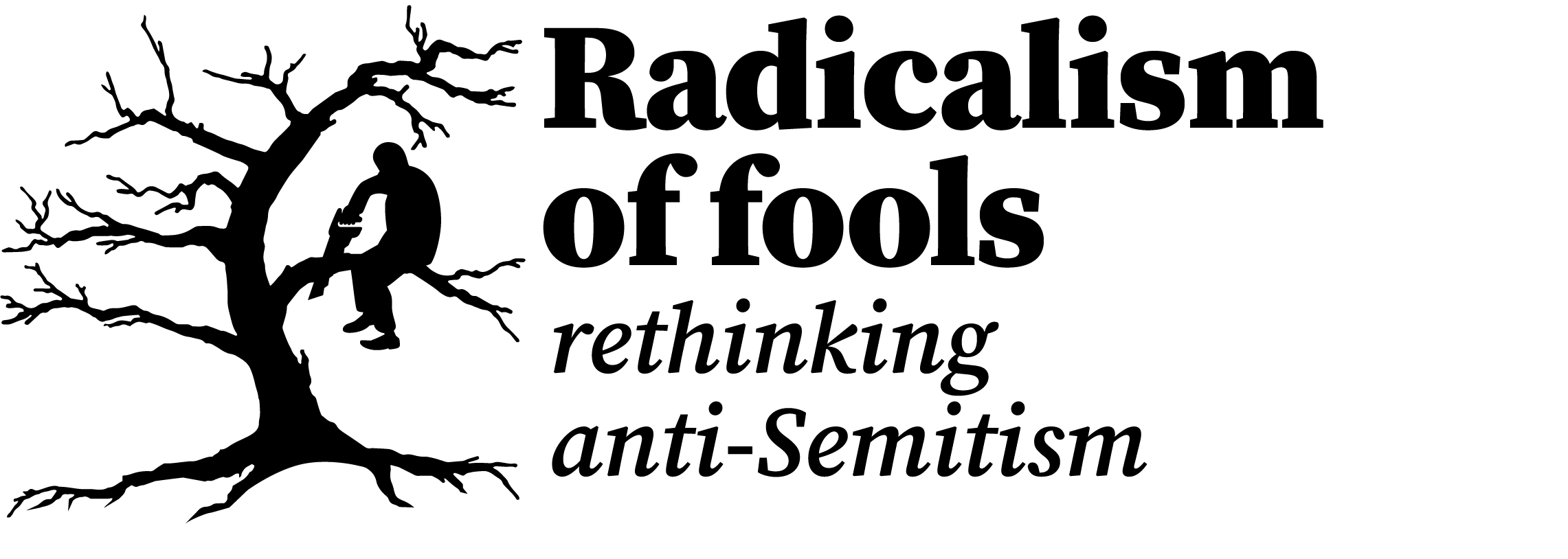Rachel Shabi’s aim in her new book, Off-White: The Truth About Anti-Semitism, seems to be to reassure those on what passes for the left these days that they are not anti-Semitic – and that accusations that they are anti-Semitic are just, as she puts it, ‘a stick with which the right clobbers the left’. Little wonder, perhaps, that Off-White has already won praise from various leftist luminaries.
Shabi herself is a self-avowed ‘progressive’ and a veteran Israeli-born British journalist of Iraqi Jewish origin. In Off-White, she seeks to apply contemporary ‘frames of analysis’ common on the left to the subject of anti-Semitism. In practice, this means reconceiving anti-Semitism in terms of the core ideas of the identitarian left.
Many of Shabi’s starting assumptions are conventional. She sees anti-Semitism as an ‘ancient hatred’. She also talks about how anti-Semitism is a conspiracy theory that often involves scapegoating Jews for the perceived ills of society. Few would take issue with any of this.
From there on, however, she offers up a strikingly instrumentalist history of anti-Semitism. In her view, anti-Semitism is a ‘tool’ used by ruling elites throughout history ‘to maintain their power’. Christian church leaders once needed to vilify Judaism ‘in order to ensure [Christianity’s] own spread and eventual dominance’, she says. Likewise, 19th- and 20th-century Western ruling elites needed to vilify Judaism to maintain and deepen their dominance – as evidenced by the Dreyfus Affair in France and the British government’s Aliens Act in 1905.
As Shabi sees it, there’s little difference, then, between these instances of historical anti-Semitism and other forms of racism and discrimination, such as today’s far-right targeting of refugees from Africa and the Middle East. These are all simply instances of instrumental, trans-historical prejudice.
But while anti-Semitism is presented here as one racism among many, Shabi also argues that the position of Jews has changed radically over time. After the Second World War and the Holocaust, Western elites’ view of Jews underwent a dramatic transformation, she says: ‘Jews in the West were by and large absorbed into whiteness and its corresponding power structures.’ Persisting with the jargon of critical race theory, she claims that Jews were used to ‘maintain [white privilege] as a social construct’.
Shabi argues that Jews, once they were incorporated into ‘white’ power structures, came to benefit from the oppression of non-whites. Indeed, she explicitly endorses the view that ‘the price of whiteness was to opt into anti-black racism’. Many Jews are therefore the beneficiaries of contemporary racism. How Shabi herself apparently managed to escape this malady is unclear.
As the 20th century progressed, she goes on, European powers decided to treat the newly founded Israel ‘as “fitting in” with their imperial designs elsewhere’. In other words, European powers backed Israel as a way of furthering their colonial domination over indigenous people. The Jewish State, in this telling, is an instrument for imposing Western racism on the Middle East. Shabi doesn’t mention that most Jews who fled to Israel, both from Europe and later the Middle East, had nowhere else to go. And she skates over the fact that the creation of Israel was itself a response to genocidal anti-Semitism and the abject failure of the left to fight it.
Off-White is a staggeringly crass book. It forces the complex history of anti-Semitism into a vulgar instrumentalist framework. Shabi retrospectively interprets key historical events as furthering so-called white interests. This analysis is the product of an ultimately conspiratorial mindset, in which the world is being controlled by far-right white men.
The limitations of Shabi’s approach are apparent throughout. She acknowledges anti-Semitism changes its form over time, but she draws no qualitative distinction between different types of Jew hatred.
Anti-Semitism is considerably more complex than Shabi allows. Crucially, she shows little grasp of the distinction between Christian Jew hatred and modern anti-Semitism. The old religious hatred of Jews was based on a historical Christian enmity to Judaism, bound up with the allegation that the Jews were responsible for the killing of Christ. Modern anti-Semitism, by contrast, is a racial theory that did not emerge until the 19th century.
Historically, it is not difficult to find instances of Christian hostility to Jews. Some of these are discussed in Off-White. These include the blood libel in which Jews were accused of ritually killing Christian children for their blood. An early example – some say it was the first blood libel – happened in Norwich in 1144, when Jews were accused of killing a 12-year-old boy. Persecution and the murder of Jews tended to follow such allegations.
The position and perception of Jews started to change in the late-18th century. Jews had hitherto tended to live on the margins of European society, often living in ghettos and concentrated in particular occupations, such as lending and commerce. By contrast, the majority populations tended to be rural and largely focussed on agricultural work.
This began to change with the French Revolution and, in particular, the idea of Jewish emancipation. It took many decades, but it gradually came to be accepted that Jews could be integrated into mainstream society. They could live where they liked and have full citizenship rights.
At the same time, the ideas of race and racial theory started to gain traction among European elites in response to the threat posed to them by the Enlightenment idea of equality. During the 19th century, counter-Enlightenment intellectuals argued that the innate, natural, ‘racial’ flaws of particular groups meant they were incapable of achieving social equality. Indeed, it’s no coincidence that the term ‘anti-Semitism’ was coined in the 1870s, by German journalist and politician Wilhelm Marr. Marr’s antipathy to Jews, who he conceived as a threat to ‘Germandom’, was overwhelmingly cultural and racial. Hence, he characterised his views as ‘anti-Semitism’, rather than ‘anti-Judaism’. This showed that Jew hatred was increasingly being framed in racial rather than religious terms.
The development of racial thinking was not a ruling-class conspiracy. Rather, it emerged out of the social developments and conflicts of the 19th century – as part of the ruling elites’ opposition to more and more sections of society demanding rights and freedoms. Nor was racial thinking necessarily related to skin colour. Jews could be conceived in racial terms, as indeed could sections of the white population.
Modern anti-Semitism was also different from Christian Jew hatred in other ways. Jews were certainly killed in pre-modern times. But in the modern era of racial thinking, Jew hatred acquired a genocidal dynamic. This was apparent not just in the Holocaust, but also in the pogroms in Poland and Ukraine after the First World War. According to one authoritative estimate, the latter led to the slaughter of nearly 100,000 Jews.
It is true that pre-modern tropes still dominate the discourse of modern anti-Semitism. For example, variations of the blood libel can be seen at contemporary anti-Israel protests, with Israel portrayed as delighting in the murder of Palestinian children. But the context is different. The blood libel was originally a grotesque expression of a pre-modern religious rivalry. Today, it expresses a racial view of Jews as almost naturally inclined to kill kids.
Another key aspect of anti-Semitism overlooked by Shabi is that it tends to present Jews as the personification of evil. In the late 19th and early 20th century, this was often bound up with the idea that Jews were the embodiment of speculative capitalism. At times of financial turmoil, it therefore became easy to blame Jews. At other times, especially in the aftermath of the First World War, Jews were identified with Communism. For the Nazis, Jews personified the evils of both capitalism and Communism at the same time.
More recently, however, Israel itself has come to be cast as a supremely malevolent force. Today’s anti-Israel activists do not simply criticise the actions or policies of the Israeli government, as they might the actions of other nations’ rulers. Instead, they damn Israel as a whole. They hold Israel up as the epitome of evil in the world, morally condemning it as an ‘apartheid’ or ‘settler colonial’ state, and ultimately calling for its destruction.
All too often, Off-White plays into the hands of today’s anti-Israel activists. The creed of identity politics to which Shabi seemingly cleaves is itself a driving force of the new anti-Israeli hysteria, which has helped to rehabilitate anti-Semitism on the left. Israel is depicted as a ‘white’, colonial outpost – with Jews cast as oppressors in a predetermined racial hierarchy.
Shabi also fails to see that the left’s obsession with Israel, its presentation of it as the personification of evil, is itself a form of anti-Semitism, given no other state is subjected to this kind of unhinged condemnation. To counter this argument, she claims that leftists, in the tradition of international socialism, also focus on conflicts in such places as Iraq, Sudan, Syria and Yemen. But the fact is that criticism of the regimes involved in those conflicts is nowhere near as visceral or as filled with loathing as that directed towards the Jewish State.
Shabi similarly omits to mention the glaring and well-documented anti-Semitism of the political movements now at war with Israel, such as Hamas and Hezbollah. She even dismisses the charge that Hamas is annihilationist, despite the content of Hamas’s 1988 charter – a document, never rescinded, that explicitly calls for the extermination of Jews. The charter also blames Jews for the French Revolution, the Russian Revolution and two world wars. It is a document that, in a different context, would be accurately described as far right.
Despite the claims of its subtitle, Off-White does not tell the truth about anti-Semitism. Shabi argues that Jews benefit from white privilege and, in doing so, she unwittingly reinforces the intellectual trends that underpin the new anti-Semitism and the hysterical demonisation of Israel. She may see herself as ‘progressive’, but with Off-White, she ends up playing into the hands of some of the most reactionary movements on Earth.
This article first appeared on spiked. The original version can be read HERE.

